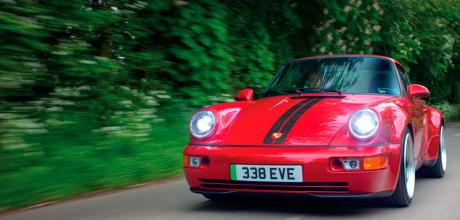E-powered 507hp Everrati 500bhp Porsche 911 964 driven
Electric 964 Everrati’s reimagined 964 has swapped its flat six engine for e-power. Total 911 is one of the first to drive it. A beloved 964 has been converted to e-power, but can it offer the same excitement as an original factory-spec 911 with a flat six engine? Written by Tim Pitt. Photography by Alex Penfold.
Future Shock
Electric-powered 507hp Everrati 500bhp Porsche 911 964 driven
Air or water cooled, naturally aspirated or turbocharged, a flat six engine has been the beating heart of our favourite sports car since 1964. Transplant it for an electric motor and do you still have a 911? More pertinently, perhaps, can it excite petrolheads like you and me? Justin Lunny thinks so. The CEO of Everrati prefers the term ‘motorhead’, but his passion for cars isn’t confined to EVs. “I’ve owned plenty of 911s over the years, most recently a 991 Carrera S and 991.2 GT3 RS,” he reveals. “My daily driver is a Taycan Turbo S, but this car is lighter, more agile and simply more fun.”
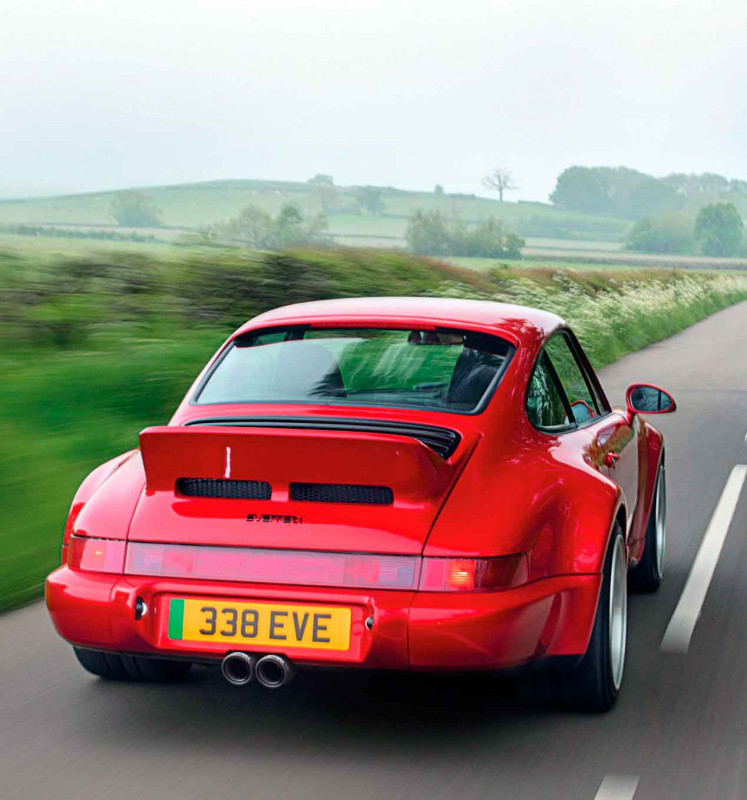
Lunny’s lightbulb moments both happened close to home. “I saw how worried my daughter was about climate change,” he says. “It forced me to confront the issue.” Also, in 2018, the family lived opposite Windsor Castle and watched as the newly wed Prince Harry and Meghan Markle left the chapel in the Jaguar E-Type Concept Zero. The electrified classic never made production, but Lunny had sensed a gap in the market. “Unless you were able to spend £2 million on an electric hypercar, there weren’t any EVs aimed at drivers.”
The tech entrepreneur assembled a small but talented team. Co-founder Nick Williams, who Lunny met at Le Mans, is a marketing specialist who raised the profile of AMG in the UK. Director of engineering Mike Kerr, meanwhile, has an enviable CV that includes stints at McLaren, Lotus, Cosworth Racing and transmission maker Xtrac. He also happens to have a left-hand-drive 964 Carrera 2, bought while supporting the DTM championship in Germany. “I’m the second owner from new,” he says. “It’s a car for special occasions.”
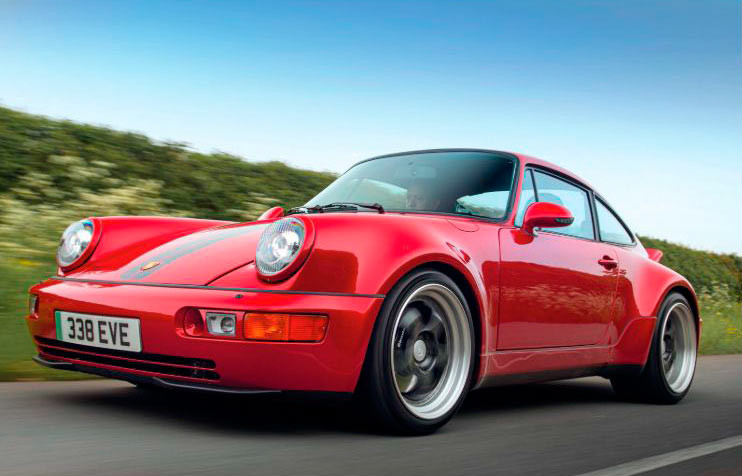
Like many companies that ‘reimagine’ Porsches, Everrati looked to the 964 as its starting point. “Other 911 models are certainly possible – and the 993 is an obvious evolution,” explains Kerr. “Its multi-link rear suspension is the limiting factor, though. Packaging all the batteries is one of the main challenges with electric cars.”
Kerr’s first prototype was a C2 Targa fitted with the Large Drive Unit from a Tesla Model S. Outputs of 446hp and 460Nm meant 0-62mph in 4.5 seconds – quicker than a 964 Turbo S. This second Everrati takes things a stage further, with the drivetrain from the Model S Performance. The numbers quoted are 507hp, 500Nm and 62mph in less than four seconds. “The best I’ve managed is 3.85 seconds,” Kerr grins. “No factory-built 964 comes close.”
Still, excrement-off-a-shovel acceleration is nothing new when it comes to EVs: the Taycan already offers that in, well, spades. Yet while the modern Porsche weighs upwards of 2.1 tonnes, the Everrati tips the scales at a sprightly 1,400kg: exactly half-way between a 964 C2 and C4. The placement of the lithium-ion battery modules, with eight in the front boot (leaving space for a couple of shopping bags) and 16 beneath the engine lid, also means 40:60 front:rear weight distribution – almost identical to the original car.
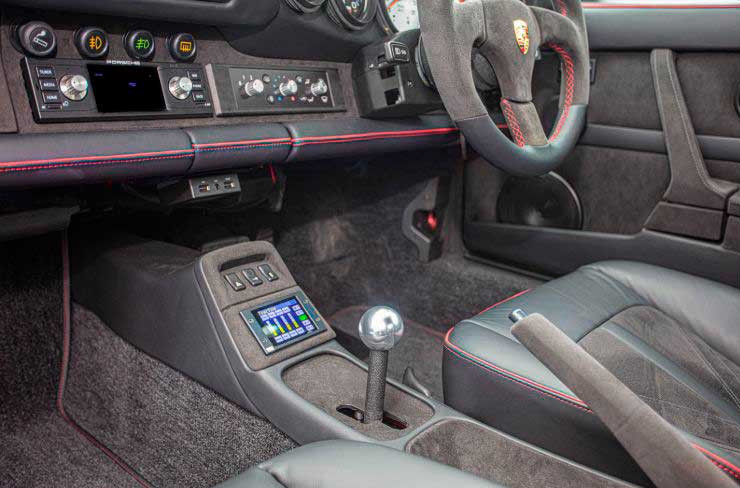
That bodes well for the driving experience, as does the involvement of BTCC and Carrera Cup champion Tim Harvey in honing the handling. “He helped determine the settings for the electronic dampers,” says Lunny. “They’re made by Tractive, a Dutch brand popular as a retro-fit for newer 911s with PASM.” Harvey is also developing a work-in-progress Race mode, which will make the car keener to go sideways. It’s in addition to existing Sport and Eco settings, the latter designed to eke out more range.
Ah yes, range: the issue most cited by owners of ICE cars as their greatest deterrent to going electric. As with the 2,000hp Lotus Evija – Kerr’s final project before joining Everrati – the 964 strikes a balance that errs towards light weight rather than more mileage. Its 53kWh battery capacity (50kWh of which is usable) equates to a ‘real world’ range of 180 miles, or 150 miles for the Performance Pack car driven here. Using CCS fast charging, you can top up from 10 per cent to 100 per cent in less than an hour. “This is an A-to-A car,” reckons Williams, “so most people will charge it at home. And when the technology improves, we can upgrade it.”
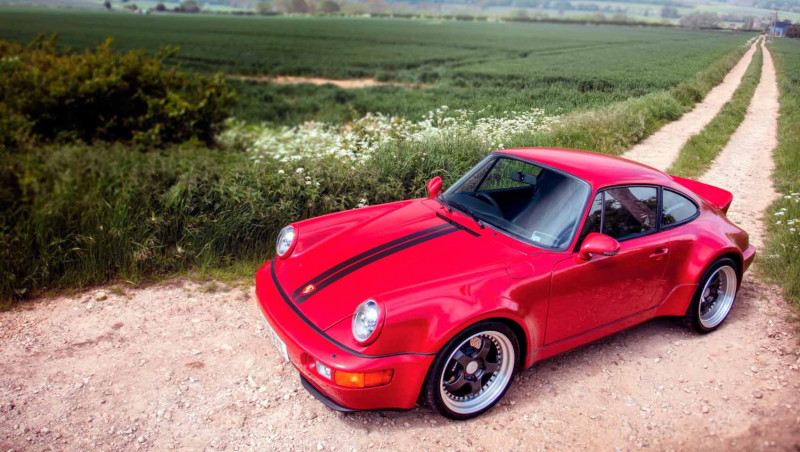
Whatever lies beneath, the emotional suckerpunch of the classic 964 shape hasn’t diminished – particularly in brawny widebody guise. This is Everrati’s ‘Signature’ specification, with a carbon fibre roof, bonnet, wings, doors and ducktail that collectively save an extra 65kg. The bumpers are genuine 964 Turbo items, with the addition of RS Cup vents at the front. Neat details include LED headlights with ‘angel eye’ DRLs and Audi-style strobing indicators in the Cup door mirrors. Oh, and you also can’t miss the centre-exit exhaust – which is fake, obviously.
Don’t like the idea of pretend tailpipes? I’m not sure I do either, but they aren’t compulsory. Indeed, every aspect of the car can be tailored to your taste. Options include matt and pearl-effect paints, custom interior trim, 18-inch alloys, bigger brakes, upgraded audio and a reversing camera. There’s also an RSR Pack with a stripped-out cabin and rear roll cage, plus an officially licensed – and hand-painted – Gulf Racing livery for the full motorsport look.
One further option worth mentioning is (oh yes) the missing flat six engine, supplied in a Perspex display case for the ultimate in coffee table oneupmanship. Lunny points out that the EV conversion is fully reversible, with no structural changes to the chassis, so owners can retain the ‘matching numbers’ originality of their 911 if desired. “The cars we’re working on are already icons, so we need to be respectful of that,” he adds.

Climb inside and the electric 911 feels familiar but different. The standard seats have bigger bolsters and embossed Porsche crests, while the ball-topped gear lever offers a simple choice between forward, neutral and reverse. The central rev counter is now a power gauge, fuel and oil level are replaced by charge and voltage, and oil temperature and pressure readouts are swapped for battery and motor temperature. The speedo incorporates an OLED display that shows the percentage of charge remaining.
Everrati’s interior trimmer previously worked for McLaren’s bespoke MSO division and the quality of his work can’t be faulted. The dashboard is covered in supple leather with contrast red stitching, while the door cards and touch-points are swathed in tactile Alcantara. Infotainment comes courtesy of Porsche’s DIN-sized PCCM head unit, offering DAB radio and smartphone connectivity via Bluetooth, Apple CarPlay and Android Auto. There’s also a touchscreen controller for the Tractive suspension on the centre console.
Turn the key and… nothing happens. But the electric motor is primed and when I press the throttle the 911 steps away smartly. With full torque from zero rpm, the sudden shove hits you straight in the solar plexus. And with no gears to shift, acceleration just keeps on building: relentless and totally linear. A greater contrast to the all-or-nothing power delivery of a 964 Turbo is hard to imagine.
It all feels almost too easy, but Kerr’s team are working on ways to intensify the drive, such as the possibility of artificial gear changes (essentially limiting the motor’s speed in a series of pre-set ratios) and even introducing a conventional H-pattern gate. Switching on the acoustic generator – based on tech used to augment engine noise in ICE cars – also offers a more ‘traditional’ experience, including over-run pops and crackles via internal and external speakers, although it sounds more like a Detroit V8 than a Stuttgart six.
Frankly, I rather like the warp-speed whoosh of electric cars, so I soon turn off the artificial enhancement. Now the loudest noise is the rumble of the 964’s steamroller 295/30ZR18 rear tyres – track-focused Michelin Pilot Sport Cup 2s with a natural aversion to the fine drizzle which has started peppering the road. At times like this, one might wish for a Carrera 4 – “not currently an option,” says Kerr – but traction isn’t an issue, despite the Tesla drivetrain’s monstrous torque. The 911 slingshots out of corners like it’s attached to stretched elastic.
The way the Everrati slows down feels alien at first, too. Regenerative braking, which harvests friction to charge the batteries, allows ‘one-pedal’ driving around town. Back off the throttle sharply and deceleration can be swift enough to activate the brake lights. Think of a dodgem, but hopefully with fewer impacts…
On faster roads, particularly when following other traffic, I quickly find a rhythm, lifting off to slow the car for bends and hardly using the brake pedal at all. Thinking ahead and managing this smooth flow adds an element of involvement to the EV experience that you wouldn’t initially expect. Crucially, when you do need them, there is no link between the mechanical brakes and the regen system, which helps maintain a progressive and uncorrupted pedal feel.
With the Tractive suspension in its middle setting, ride quality feels similar to a standard 964: firmly damped and always busy, but rarely harsh or crashy. Dialling up the stiffness to full ‘Tim Harvey mode’ feels too much for the crumbling B-roads of Oxfordshire, or indeed the humps and potholes of inner cities, where the electric 911 is exempt from charges for congestion and low emission zones. It would be well suited to a track day, though.
If the notion of an ‘electric track day’ seems underwhelming, don’t be so sure. Aside from side-stepping any worries about decibel limits, the Everrati drives, well, very much like a 964. Its hydraulic power steering needs an electric pump to compensate for the lack of engine vacuum, but the smaller Cup wheel jostles with constant feedback. The car’s balance feels as you’d hope, too: lively at the front end and squat at the rear, with a Quaife differential to keep the monstrous torque in check. Unlike a Taycan, however, there isn’t an arsenal of stability systems to mitigate a clumsy right foot. As with any classic 911 on damp roads, the Everrati rewards commitment and requires a healthy dose of respect. I tell Kerr this is the most ‘analogue’ EV I’ve driven, and he seems happy with that.
With the notable exception of Singer, prices for the Everrati are broadly comparable to rival 964 restomods. The range starts at £240,000, rising to £300,000 for the widebody Signature Edition. This particular car, with Tractive dampers and several bespoke options, costs £336,000. None of the above includes the cost of a donor 911, though. “Customers can supply their own car or we can source one,” explains Lunny.
Electrified classics seem like a small niche, but Everrati has ambitious plans. It hopes to convert 50 911s a year by 2025, plus around 50 additional cars. Other models currently in development include a Land Rover Series II (“not with 500hp this time,” stresses Kerr) and a Mercedes-Benz SL ‘Pagoda’. There’s also a limited-run supercar due later this year, which “won’t be Porsche-based”. The company’s brochure briefly mentions the Ford GT40, which may be a clue.
Further ahead, Everrati also wants to move away from Tesla motors and batteries and develop its own one-size-fits-all EV hardware kits. “We’ll be able to offer front-, rear- or four-wheel drive,” explains Lunny.
“This won’t be a skateboard-style platform, but a package of components to convert any classic.” Will that make classic cars more homogenous?
No doubt. Yet if they can still be driven, seen and enjoyed, especially beyond 2030, maybe it’s not such a bad thing. And the Everrati 911 truly can be enjoyed, not least on roads where typical white-goods EVs feel out of their depth. I won’t pretend I didn’t miss the howl of a flat six, but many virtues fill that void, such as instant torque and effortless speed, plus near-silent serenity and one-pedal convenience when you’re not in the mood. The cleaner conscience and lower tax bill that come with owning an EV certainly help, too.
If Porsche gets its way, the future may not be entirely electric. Zuffenhausen plans to start producing cleaner synthetic fuels for use in existing ICE cars from 2022. So you may, hopefully, be able to carry on driving your 964 for decades to come. I rather like the idea of an Everrati for weekdays and a flat six original for weekends. Maybe this versatile electric 911 is more of an A-to-B car after all.
Model Everrati Porsche 911 Signature Edition 964
- Year 2021
- Engine Battery pack 53kWh
- Maximum charging speed 100kW
- Maximum power 507bhp
- Maximum torque 500Nm
- Transmission Single-speed manual
- Suspension
- Front MacPherson struts; transverse arms; coil springs
- Rear Semi-trailing arms, coil springs
- Wheels & tyres
- Front 9x18-inch 245/35/ZR18
- Rear 11.5x18-inch 295/30/ZR18
- Dimensions
- Length 4,250mm
- Width 1,775mm
- Weight 1,400kg
- Performance
- 0-62mph 3.85sec
- Top speed 130mph
- Electric range 150 miles
RIGHT Inside the 964, it’s not immediately obvious this is powered by an electric motor, with a manual gear shifter and transmission tunnel present.
BELOW Tachometer is replaced with a power gauge, with retro-styled needles.
BELOW Charge connection is housed under the 964’s traditional fuel filler.
BELOW Tractive screen allows for on-the-go suspension tweaks.


